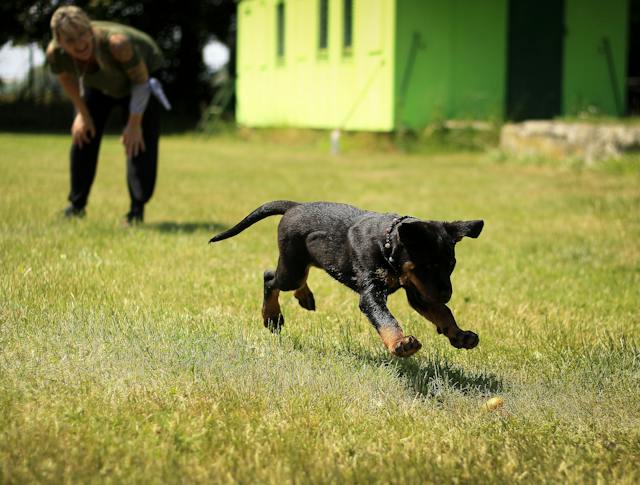The definition of psychology is how our brain performs work and makes our overall behavior. Thus dog psychology means how dogs learn and behave. And, how they behave and interact with other dogs, and with their owners. In this article, we’ll try to explain dog training and psychology.

Understanding Dog Training and Psychology?
There are a lot of people that will adopt a dog today, and they will ask this question outright, why should I train my dog? And, also why it is important to understand Dog Training and Psychology?
There are a lot of answers that can be given, and in the end, they all can be valid. However, when you start to break down some of them, you’ll realize that some have a heftier weight than others. It’s for that reason that the following answers are worth exploring when you get a new pet. Whether you have a brand new puppy or you’ve decided to adopt an older dog, there are a few reasons why training matters, especially today.
1-The Bond
When you have any animal enter your home, you want them to have a bond of security, safety, and love. Pets can be fragile in terms of psychology, especially if you have chosen to adopt one that has been harmed in the past. To enforce the bond that you and they have with you and your family, Dog Training and Psychology helps. Strengthening the bond that you have with them hinges on whether or not you can establish training regimens and more.
2-Stimulation of the Dog’s Brain
A dog’s brain needs stimulation, much like a child’s brain does when they are growing up. When you decide to train early, you will help stimulate the brain and nourish them overall. The benefits of this will be evident over time, as you will find that your dog will become easier to manage, play with, and will be responsive to commands, etc.
3-Eliminates Behavioral Problems
Dogs can get out of hand if left untrained. Meaning that they could end up behaving in manners that you may not like. For instance, dogs may chew your furniture, they may defecate in the home, and much more. You don’t want them to be a handful, and you want them to be well-behaved. That’s where training comes into mind. It helps them not only have a code of conduct, but it helps you out in the home.
4-Builds Confidence
There’s a certain confidence that is becoming a good dog. Training helps them in being confident when around other dogs, and people, and even defensive if they’re in trouble. If someone breaks into your home, your well-trained dog will fight them off. If your child is at risk, they may try to fend off someone or may run and bark to signal trouble.
5-Fun
Perhaps the best thing that comes from training is in regards to fun. While paying attention to Dog Training and Psychology, you can ensure that you and your dog can have a lifetime of fun by simply training them to obey your commands. You can roam dog parks, and the public without having to worry about them fighting or being scared. The fun ramps up when you can corral your pet and know that they will be ok to walk with, or simply have in your home. Whether you want a family dog or you want a personal pet, training is never a bad idea. It can be done at puppy age or older and works best when you know how to work with Dog Training and Psychology.
How Dogs Learn
The number one reason why people fail at training their dogs is that they don’t know they learn. If you’re honest with yourself, you’ll realize that you may not have an answer to the notion. When you look at how dogs learn, you will break through the training process in a whole new way. Many people have learned this the hard way, and it’s fascinating to see how it all turns out. There are several things that you will learn when you start to train your puppy or older dog. It’s all in how you approach it. Some will scoff at the notion, but honestly, it’s not a difficult thing to learn and understand.
Repetition and Reward
The first major thing that you should know about how dogs learn is simple, rewards. If you have ever seen the training process of multiple pets at once, you’ll see that the way to get them to obey is to reward them after you make a command. Whether you want them to sit down, or you want them to stop barking, rewards help greatly. Now, some may argue that they will always expect a treat when they listen. But that’s something that you won’t need every time. It’s a process that takes time to master but done right, you’ll absolutely be able to engage them without giving them treats each time. It’s a balancing act, but repetition is key, and rewards help at first.
Consistency
Dogs are creatures of habit, much like adults are. Most owners get flustered, and impatient when dealing with the training process. That’s not a good thing. Teaching dogs to learn just about any behavior is a matter of consistency and pattern. That means that you may need to be a bit more disciplined as well. Your discipline matters, including times when you get up, feed and walk your pet. If you slip up, they notice, so you have to remain consistent in how you behave and then teach them your way of behaving.
Focusing On Small Things First for dog training and psychology
Another thing that you need to know about how dogs learn is regarded the notion of smaller milestones. Many people want their dog to transition from disobedience into a perfect pet overnight. That’s not how they learn. You can modify behavior on the fly, but again, you’re going to have to be consistent. With that in mind, you should work on small behavior issues first and continually move forward with that notion. Small victories will add up, and you will eventually get to where you want to be with your pet. However, that’s going to take some discipline and guidance. Once you reach your first milestone, go to the next, and build on that success until you have a docile, welcoming dog.
Learning how dogs learn is the key to success with the training. This becomes especially true for those that are trying to gain the upper hand with an older pet. Old dogs can learn behavior modification, it just takes a bit of work and patience. Having a good guide on your hands is also helpful.
Easiest Dogs To Train
There are a lot of different breeds of dogs that you can call your best friend. Some dogs are easy to train and then some dogs can cause a lot of headaches. There’s no wrong way to look at this, but if you’re going to plan far ahead in advance in regards to adopting a dog, you should look at some that are easy to train. This is especially true if you don’t have a lot of time to invest in a pet’s upbringing. With that in mind, here are a few dogs that are easy to train and can be quite fun to be around right away.
The Bernese Mountain Dog
Now, this is a dog that will be interesting to outdoorsy people. This is a mountain dog by name and loves being outdoors. The breed is easy to train and has been one of the most iconic dogs in terms of farming and mountaineering the same. They can be big, but are cuddly, and usually have great personalities when around new people, new dogs, and small children.
The Border Collie
These are absolutely smart pets. They not only are easy to train, but they also tend to have instincts when it comes to herding children, protecting family members from threats, and much more. When trained, they can do a lot of things, more than just tricks, and can even emulate cats in a way that they don’t need a lot of attention throughout the day.
The Shetland Sheepdog
When it comes to dogs and training, you will want to look into the Shetland Sheepdog. This is a dog that is easy to train and is very active. If you have a large yard, they’ll entertain themselves by running around, jumping, and playing. You need to play with them a bit, but other than that, they are great dogs to have around a family and are loads of fun throughout their lives. Even so, they are easy to train.
The Brussels Griffon
Speaking of smart dogs, the Griffon is an interesting dog that resembles a muppet. It’s smart, easy to play with and train, and can be an indoor pet that is fun to be around. Training is simple, and while many categorize this pet in the “toy” breed category, they certainly showcase a lot more than just those attributes.
The Doberman Pinscher
Don’t let their looks fool you, they are docile dogs when trained. Even though they were initially bred to protect tax collectors, they are truly loyal and gentle. When trained properly, they can become one of the most compelling and easy-going dogs to have around. They can be a bit high-strung early on, but that goes down a bit. They emulate their owners in terms of personality sometimes, so watch out.
The above list is just a handful of breeds that you will want to look into if you’re seeking an easy route with training. The right training is all about the psychology of the dog. When you know that, you will be easily guided through the training process. Even older dogs can learn new tricks when you understand their psychology.
Hardest Dogs to Train
When it comes to domesticating pets, there’s been a lot of time for men to work with them. When you think about cats and dogs, you will realize that they have been pets for thousands of years. There’s a unique attachment that comes with raising a pet today, and you may find that you will want to train them through a variety of methods. With that in mind, you will no doubt want to look at what dogs are hard to train and which ones are easier. The following is a list of dogs that are hard to train, but that doesn’t mean it’s impossible.
The American Pit Bull Terrier
The older this dog gets, the more difficult it could be to train. The reason is that they have been trained to be cruel in the past. You’re going to have to get into the psychology of dogs and work with this breed if you want them to be social. They are great family dogs, but only if they are trained and loved carefully. Even older dogs of this breed can be trained, but you’ll need to be very careful and deliberate in your training.
The Bullmastiff
This is a very large dog, and if trained right, can protect you and your family. However, they are also temperamental and don’t know their strength. It’s not uncommon to read stories of owners that are harmed because of them. They don’t like a lot of other pets, or dogs, and can lash out at people when not trained. You will need to spend time working with them and pay attention to their needs early on. They can be upwards of 130 pounds easily.
The Siberian Husky
The Siberian Husky can be a workhorse for those in the artic. However, outside of the cold weather, people find their playful attitude to be difficult to manage. They were bred to be work dogs, so they require a bit of instruction early on. You have to commit to a lot of serious training as they can be bored easily and misbehave as a result.
The Chow Chow
These lovely dogs resemble teddy bears and can have long hair and be very stubborn. Their stubbornness comes from their need to have a lot of attention thrown their way. They can also be aggressive, and territorial at times. So you must understand different aspects of Dog Training and Psychology while training them. They are not good with new pets and can be tough with children. However, when trained by a diligent owner, they can be tamed and friendly beyond compare. They need proper, deliberate training, however.
The Akita
Last on this list, but certainly not least, the Akita is a wonderful dog that is beautiful and friendly. However, they require a lot of attention and proper training. They need to be active a lot, including no less than 30 minutes to an hour a day of deliberate movement. Otherwise, they can become lethargic, cranky, and off-putting. They can also weigh upwards of 100 pounds and over, so it’s difficult to train them for some owners.
Some things You may not know about Dog Training and Psychology
When it comes to training dogs, many people assume that things are difficult. The reason why so many jump to this conclusion is simple, they are told horror stories from others that have tried to teach their pets to be obedient. Most people fail to do this on their own, and it’s simply because they don’t know what to do or how to do it effectively. Mainly because they don’t understand dog psychology. There’s a psychology to training that most people just don’t spend time learning. It’s for that reason that the following has been compiled, to help with this issue and create a better understanding of how to train dogs to be more obedient.
They Give Respect
The first thing that most people don’t realize about dogs is that they give and honor respect. This is something that the United States Military trainers will tell you. Once you gain the respect of a dog, they will listen, and become your best friend. They’ll be set to mold into any type of pet you want, as long as you know how to build this relationship properly. It may take a little time upfront, but in time, you’re going to be impressed with how simple this can be.
Be Serious About Training
When discussing dog psychology, many people only want the cuddling and affection that dogs bring. That’s not a good thing to dwell on. Yes, that’s a good thing at times, but you need to carry certain professionalism in training. When you’re training, you need to be serious, you need to lead with certain stability in mind, and you need to remain steadfast in your commands. Dogs respond to this, because they need a leader, and you can become that, if you are steadfast, serious, and take control of the situation without nervousness or playfulness.
Treat The Good
This is a standard trick, but it’s something that works. When training, reward a dog with treats as they do good. Dog psychology works in rewards when learning. You don’t need to give a ton of treats, but in time, you will need to give them something for their obedience, and then wean them back off treats for obedience. It’s a balancing act that works very well and has been used by experts around the world.
Discipline Is Necessary
Dogs have a psychology that is somewhat fragile at times. Punishing them can cause them to snap, but there are ways to discipline them that won’t be harsh. You need to know what is going to work here. Professional trainers argue this point, but the key is to be able to have a non-verbal command that will show your dog that they are doing something you don’t want them to do. That doesn’t mean hitting or harming them. Yelling doesn’t work either. A non-verbal sound or noise and a slight gesture and repositioning can work well here.
Exercise and Training Go Hand In Hand
The number one thing about dog psychology is simple, exercise helps reinforce the training. Training your dog is going to be a task that becomes easier when you are active with them. Active pets learn better, create better relationships, and do not become lethargic or lose focus. It’s the same as with a human that doesn’t exercise, becomes tired, obese, and fails to love life. Training should be in light of the activity, as it balances everything quite well.
——————————————————————————————————————–
Find here some very useful products related to pets
How To Train Your Puppy, Cat training, Dog health exposed, Best training techniques, Curb Your Cat
Useful Business Links: If you want to get money and improve your business, get valuable information from the following links.
Forex Starlight, Fibo Quantum, Forex Product, Forex Heartbeat, Crypto Quantum Leap, Project Serenity, Exynox Scalper, Forex Product
For an excellent experience of web hosting and domain, please click here
Are you a dog lover? if you’re then you can have excellent training techniques for the perfect behavior of your puppies here

——————————————————————————————————————–










